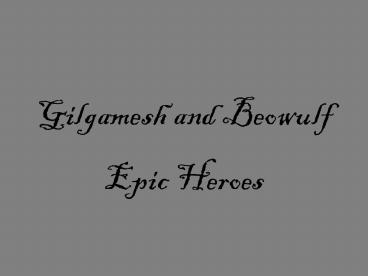Gilgamesh and Beowulf - PowerPoint PPT Presentation
1 / 21
Title:
Gilgamesh and Beowulf
Description:
Gilgamesh and Beowulf Epic Heroes Map of Mesopotamia (Gilgamesh is 3,700 years old) Modern Iraq (for now) Gilgamesh Tablet In 1872, George Smith was working at ... – PowerPoint PPT presentation
Number of Views:181
Avg rating:3.0/5.0
Title: Gilgamesh and Beowulf
1
Gilgamesh and Beowulf
- Epic Heroes
2
Map of Mesopotamia (Gilgamesh is 3,700 years old)
3
Modern Iraq (for now)
4
Gilgamesh Tablet
- In 1872, George Smith was working at
the British Museum. On a long table were pieces
of clay tablets, among the hundreds of thousands
that archaeologists had shipped back to London
from Nineveh, in present-day Iraq,. Many of the
fragments bore cuneiform hieroglyphs. Smith was a
self-taught linguist and never went to high
school. He was the first to read the story in
over 2,000 years. - Keep in mind the difficulty there must have been
(still is) in trying to figure out exactly how
the story went and what it could mean.
5
(No Transcript)
6
Gilgamesh slaying the bull of heaven
7
Shamash the Sun god
8
Humbaba
9
The Hero Myth Leaving home to come home
10
The Hero Myth (rough) outline
- Gilgamesh leaves home with helper, Enkidu, to
begin adventure (Frodo and Sam?) - Hero enters other world (woods)
- Gilgamesh must undergo testshe defeats the
monster Humbaba, slays Bull of Heaven, etc. - Lessons Gilgamesh goes off to learn the secret
of immortality. The boon (prize) is the
knowledge that immortality is for the gods only.
Notice the motif of the evil serpent connected to
knowledge humans shouldnt have - The story, like many epics, have the hero come
full circle (back home), but with a new
outlook/knowledge about humanity. Notice how
Gilgamesh is now the narrator at the end.
11
(No Transcript)
12
The Geography of Beowulf
13
Anglo-Saxon England
14
Key Dates
- 43 Roman invasions of Britain under Claudius
begin - 382 St. Jerome Latin version of the Bible
- 429 Germanus comes to Britain to convert
people to Christianity - 449 Germanic tribes called Angles, Saxons and
Jutes by Bede (Ecclesiastical History of the
English People ) invade Britain - 594 Gregory of Tours writes of a Danish king
Hygelac. This is the only dated event in
Beowulf that can be attested from an
independent source
15
- 780 Vikings attack England (first Viking age)
- 871 Alfred the Great reigns after winning
victory over Danish leader Guthrum. One of their
agreed treaty points - We earnestly forbid every heathen practice.
It is heathen practice if one worships idols
namely, if one worships heathen gods and the sun
or the moon, fire or surges of water, wells or
stones or any kind of forest trees or if one
practices witchcraft, or causes death by any
means, either by sacrifice or divination, or
takes part in delusions of this sort. - 980-1066 Second Viking age
- 1000 Compilation of Beowulf (redaction like
Bible) - 1066 William the Conqueror is crowned William I,
King of England. This Norman Invasion changed
England from a Scandinavian influence to French
16
Sutton Hoo
- Sutton Hoo is an estate near Woodbridge,
Suffolk, England, that is the site of an early
grave of an Anglo-Saxon king (compare with lines
34-45 in Beowulf)
17
- In the burial site there were 41 items of
solid gold, now held in the British Museum. The
ship also contained 37 coins, a helmet, a
necklace and a shield mount, all of gold.
18
9th century Viking ship
19
Type of Neck ring given to Beowulf by Wealhtheow
20
The Danes
- The Danes were residents of Denmark
- The Scylding line is known through Scandinavian
and Anglo-Saxon sources the Anglo-Saxon king
Cnut (1016-1042, a period coincident with the
composition of the Beowulf manuscript) is known
to have descended from this line.
21
The Geats
- The Geats were Beowulf's clan - a seafaring tribe
residing in the south of Sweden. As the poem
suggests, the Geats appear to have been conquered
and disappeared into history.































